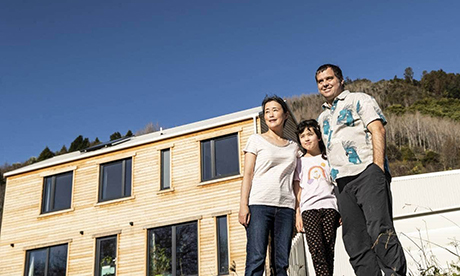Nelson architect Nathan Edmondston and his wife, Yuki Fukuda, are enjoying a warm and energy-efficient winter in their home, which recently achieved New Zealand’s highest sustainability rating.
Since moving into their three-bedroom house in Nelson a year ago, the temperature inside has never dropped below 19 degrees Celsius, thanks to its exceptional design and adherence to sustainable principles.
The home, the only certified passive house in the city, was awarded a 10 Homestar rating by the NZ Green Building Council (NZGBC). It’s an accolade held by only seven homes nationwide.
NZGBC chief executive Andrew Eagles praised the dwelling as “truly outstanding,” commending its environmentally responsible materials, energy reduction strategies, and creation of healthy living spaces.
Edmondston and Fukuda prioritised minimising the home’s carbon footprint during the design phase. The house operates on minimal energy consumption, utilising a solar system on the roof to heat water.
Furthermore, a heat recovery ventilation system, equivalent to the electricity usage of a single lightbulb, helps maintain a dry and regulated temperature throughout the home.
By extracting warm air from areas such as the bathroom and kitchen and using it to heat fresh air from outside, the ventilation system operates optimally in the airtight structure, thanks to triple-glazed windows and strategic positioning to capture sunlight.
30% less energy annually
The couple also strongly emphasised reducing carbon emissions associated with the building materials and construction process.
The house consists predominantly of locally sourced timber from plantation forests, including its piles.
This prefabrication approach and an exterior wall system significantly increased the house’s thermal performance and reduced transport emissions.
Edmondston, a certified Passive House carpenter, and his team at Basham Building completed the house in June 2022, and it received official Passive House certification five months later.
Passive houses adhere to stringent energy efficiency standards, and the couple confirmed that their home uses 30% less energy annually than the RIBA 2030 Climate Challenge target.
In terms of heating, one oil heater suffices to warm the entire house, with only about ten hours of usage recorded last year.
The curtains also played a crucial role in maintaining comfortable temperatures by blocking or allowing sunlight, acting as a natural heating and air-conditioning system.
Edmondston advocates for broader adoption of their model by developers, highlighting that many builders continue to construct carbon-intensive concrete houses, despite the availability of sustainable alternatives.
Despite the construction cost of their home being higher compared to working with a group building company, Edmondston emphasises that the “true cost” of conventional homes fails to consider the future burden of carbon emissions and climate disasters on subsequent generations.
While the government has announced plans to mandate passive house standards for homes built from 2035, Edmondston urges developers to actively reduce their carbon impacts as soon as possible. He advocates for improved building codes to ensure buyers can trust the quality and sustainability of the homes they purchase.
Sources
Additional reading
News category: New Zealand.




